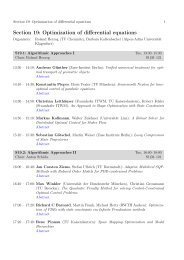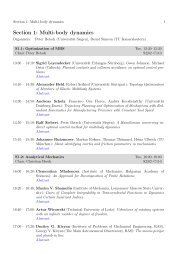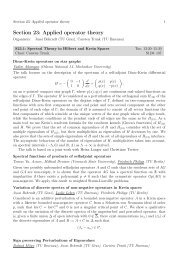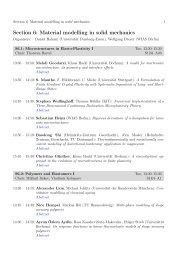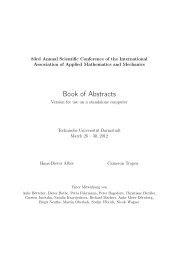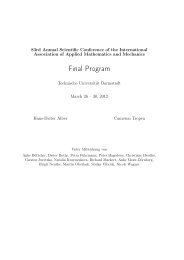Section 6: Material modelling in solid mechanics - GAMM 2012
Section 6: Material modelling in solid mechanics - GAMM 2012
Section 6: Material modelling in solid mechanics - GAMM 2012
Create successful ePaper yourself
Turn your PDF publications into a flip-book with our unique Google optimized e-Paper software.
<strong>Section</strong> 6: <strong>Material</strong> <strong>modell<strong>in</strong>g</strong> <strong>in</strong> <strong>solid</strong> <strong>mechanics</strong> 5<br />
Model<strong>in</strong>g the f<strong>in</strong>ite stra<strong>in</strong> deformation and <strong>in</strong>itial anisotropy of amorphous thermoplastic<br />
polymers<br />
Philipp Hempel, Thomas Seelig (KIT)<br />
The present work deals with model<strong>in</strong>g the temperature dependent f<strong>in</strong>ite stra<strong>in</strong> deformation behavior<br />
of amorphous thermoplastic polymers <strong>in</strong>corporat<strong>in</strong>g the effect of an <strong>in</strong>itial anisotropy. The<br />
anisotropy prevails <strong>in</strong> form of a frozen-<strong>in</strong> pre-orientation of molecular cha<strong>in</strong>s and results from preced<strong>in</strong>g<br />
manufactur<strong>in</strong>g processes (e.g. <strong>in</strong>jection mold<strong>in</strong>g) at elevated temperatures and subsequent<br />
rapid cool<strong>in</strong>g. The <strong>in</strong>itial molecular orientation affects the mechanical response <strong>in</strong> terms of flow<br />
strength and harden<strong>in</strong>g.<br />
The standard f<strong>in</strong>ite stra<strong>in</strong> k<strong>in</strong>ematics with a multiplicative split of the deformation gradient <strong>in</strong>to<br />
an elastic and plastic part is modified by <strong>in</strong>troduc<strong>in</strong>g a network deformation gradient which comprises<br />
the actual plastic deformation and the <strong>in</strong>itial (process<strong>in</strong>g <strong>in</strong>duced) pre-deformation [1],[2].<br />
As a computational example, an <strong>in</strong>jection molded plate is <strong>in</strong>vestigated which displays nonuniform<br />
shr<strong>in</strong>kage and buckl<strong>in</strong>g dur<strong>in</strong>g heat<strong>in</strong>g due to the action of the frozen-<strong>in</strong> network stress. The<br />
spatial distribution of molecular pre-orientation, and hence <strong>in</strong>itial anisotropy, <strong>in</strong> the FE model is<br />
estimated from optical birefr<strong>in</strong>gence.<br />
[1] E.M. Arruda, M.C. Boyce, Evolution of plastic anisotropy <strong>in</strong> amorphous polymers dur<strong>in</strong>g<br />
f<strong>in</strong>ite stra<strong>in</strong><strong>in</strong>g, International Journal of Plasticity (1993), 6 –697.<br />
[2] M.C. Boyce, D.M. Parks, A.S. Argon, Plastic flow <strong>in</strong> oriented glassy polymers, International<br />
Journal of Plasticity (1998), 6 – 593.<br />
Model<strong>in</strong>g of <strong>in</strong>duced anisotropy at large deformations for polymers<br />
Ismail Caylak, Rolf Mahnken (Universität Paderborn)<br />
In this presentation we develop a model to describe the <strong>in</strong>duced plasticity of polymers at large<br />
deformations. Polymers such as stretch films exhibit a pronounced strength <strong>in</strong> the load<strong>in</strong>g direction.<br />
The undeformed state of the films is isotropic, whereas after the uni-axial load<strong>in</strong>g the<br />
material becomes anisotropic. In order to consider this <strong>in</strong>duced ansiotropy dur<strong>in</strong>g the stretch<br />
process, a spectral decomposition of the <strong>in</strong>elastic Cauchy-Green tensor is done. Therefore, the<br />
yield function can be formulated as a function of the anisotropic tensor, where aga<strong>in</strong> the anisotropic<br />
tensor is a function of the maximum eigenvalue. A backward Euler scheme is used for<br />
updat<strong>in</strong>g the evolution equations, and the algorithmic tangent operator is derived. The numerical<br />
implementation of the result<strong>in</strong>g set of constitutive equations is used <strong>in</strong> a f<strong>in</strong>ite element program<br />
and for parameter identification.<br />
S6.3: Microstructures <strong>in</strong> Elasto-Plasticity II Tue, 16:00–18:00<br />
Chair: Dennis Kochmann, Sebastian He<strong>in</strong>z S1|01–A03<br />
Microstructure development <strong>in</strong> a Cosserat cont<strong>in</strong>uum as a consequence of energy<br />
relaxation<br />
Muhammad Sabeel Khan, Klaus Hackl (Universität Bochum)<br />
A rate-<strong>in</strong>dependent <strong>in</strong>elastic material model for a Cosserat cont<strong>in</strong>uum is presented. The free energy<br />
of the material is enriched with an <strong>in</strong>teraction potential tak<strong>in</strong>g <strong>in</strong>to account the <strong>in</strong>tergranular



